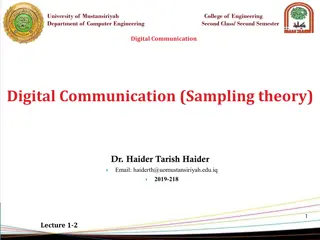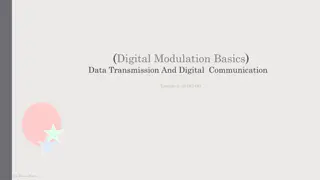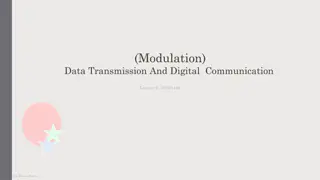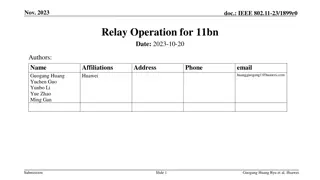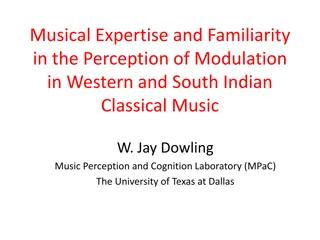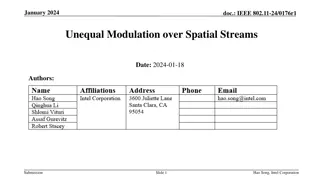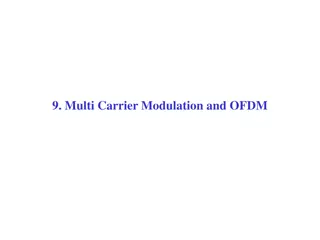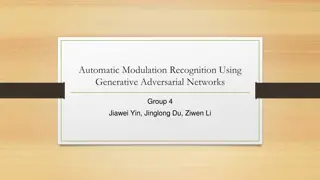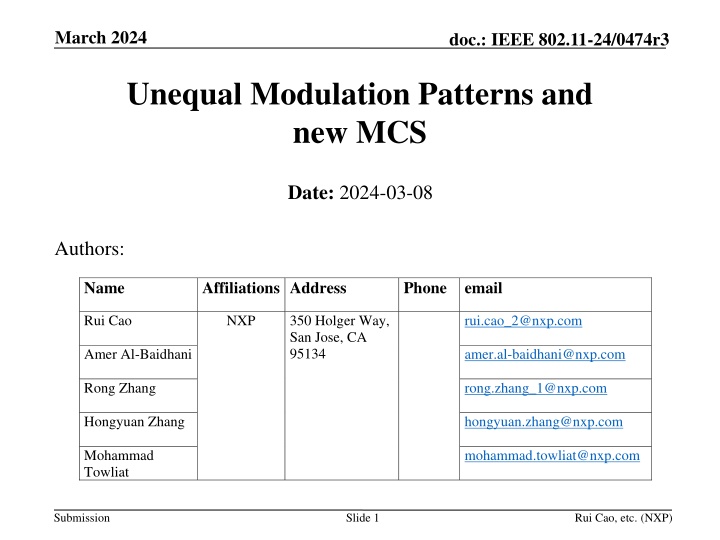
Unequal Modulation Patterns and New MCS Evaluation in IEEE 802.11-24
Explore the potential of unequal modulation patterns and new MCS additions in IEEE 802.11-24 for enhanced MIMO performance. Evaluation includes balancing gain and complexity, optimizing QAM levels, and selecting the most effective modulation combinations. Discover insights on maximizing throughput and optimizing rate selection criteria.
Download Presentation

Please find below an Image/Link to download the presentation.
The content on the website is provided AS IS for your information and personal use only. It may not be sold, licensed, or shared on other websites without obtaining consent from the author. If you encounter any issues during the download, it is possible that the publisher has removed the file from their server.
You are allowed to download the files provided on this website for personal or commercial use, subject to the condition that they are used lawfully. All files are the property of their respective owners.
The content on the website is provided AS IS for your information and personal use only. It may not be sold, licensed, or shared on other websites without obtaining consent from the author.
E N D
Presentation Transcript
March 2024 doc.: IEEE 802.11-24/0474r3 Unequal Modulation Patterns and new MCS Date: 2024-03-08 Authors: Name Affiliations Address Phone email NXP Rui Cao 350 Holger Way, San Jose, CA 95134 rui.cao_2@nxp.com Amer Al-Baidhani amer.al-baidhani@nxp.com rong.zhang_1@nxp.com Rong Zhang Hongyuan Zhang hongyuan.zhang@nxp.com Mohammad Towliat mohammad.towliat@nxp.com Submission Slide 1 Rui Cao, etc. (NXP)
March 2024 doc.: IEEE 802.11-24/0474r3 Introduction Unequal modulation has been proposed as a promising technology for UHR to enhance MIMO RvR [1~3]. In this contribution, we will further evaluate the useful unequal modulation combinations, and investigate the benefits of adding several new MCSs. Submission Slide 2 Rui Cao, etc. (NXP)
March 2024 doc.: IEEE 802.11-24/0474r3 UEQM QAM levels UQAM examples: E.g. 2ss, [256-QAM, 64-QAM] E.g. 4ss, [1K-QAM, 1K-QAM, 256-QAM, 64-QAM] Existing MCS has 7 QAM level Limit the maximum Nss for UEQM to 4ss Potentially has 100+ options for 4ss Need to reduce the combinations to balance gain and complexity Submission Slide 3 Rui Cao, etc. (NXP)
August 2023 doc.: IEEE 802.11-24/0474r3 2x2: UEQM QAM Level 1 QAM level diff: achieves most gains, but show losses across entire SNR range 2 QAM level diff: achieves all gains with minor difference Submission Slide 4 Rui Cao, etc. (NXP)
March 2024 doc.: IEEE 802.11-24/0474r3 4x4: UEQM QAM Level Both 3ss and 4ss EQM/UEQM are considered at each SNR points Limit to 2 QAM level difference achieves most of the gains, with limited impact in middle SNR region Submission Slide 5 Rui Cao, etc. (NXP)
March 2024 doc.: IEEE 802.11-24/0474r3 UEQM QAM Selection Balancing between gain and complexity, 2-level QAM difference is sweet spot. For up to 4ss, still up to 9 combinations for each MCS. Further mode reduction to choose the most useful QAM combinations: Per-channel PER simulation and per-channel per-SNR point optimal rate selection, i.e. manual rate adaptation Rate selection criteria UEQM is selected if >=4% higher goodput than existing MCS Smallest rate difference between adjacent MCSs is 8% (MCS11 to MCS12) Avoid the biased count at high-SNR points Rank each UEQM QAM pattern by the occurrence count across all configurations, channels, SNR points Submission Slide 6 Rui Cao, etc. (NXP)
March 2024 doc.: IEEE 802.11-24/0474r3 4x4 UEQM Rank 4ss 3ss M1 0 0 M2 0 0 M2 -1 0 M4 -2 -2 % M1 M2 M2 % 21.05 15.79 0 0 -2 25.93 0 -1 -2 22.22 Blos 0 0 -1 0 -2 -1 -2 -1 15.79 10.53 0 0 -1 18.52 0 -1 -1 11.11 0 0 0 0 0 0 0 -1 -2 0 0 -1 -2 -1 0 -2 10.53 10.53 10.53 5.26 0 -2 -2 11.11 0 0 0 11.11 M1 M2 M2 M4 % M1 M2 M2 % 0 0 -1 -2 20 0 -1 -2 25.93 0 0 0 -2 14.29 0 -1 -1 25.93 DNLos 0 0 -1 -1 14.29 0 0 -1 18.52 0 0 -2 14.81 0 -1 -2 -2 14.29 0 -2 -2 14.81 0 0 -2 -2 11.43 0 0 0 -1 11.43 0 0 -1 -1 -1 -1 -2 -1 11.43 2.86 Submission Slide 7 Rui Cao, etc. (NXP)
March 2024 doc.: IEEE 802.11-24/0474r3 4x4 UEQM Choices 3ss: M1 M2 M3 0 -1 0 0 0 0 -1 -2 -2 4ss M1 0 0 0 0 0 0 M2 0 0 -1 -1 0 0 M3 -1 0 -1 -2 -1 0 M4 -2 -2 -2 -2 -1 -1 Option 1 Option 2 Option 3 Option 4 Submission Slide 8 Rui Cao, etc. (NXP)
March 2024 doc.: IEEE 802.11-24/0474r3 DNLos 4x4 Goodput Gain [0 0 0 -1] shows good benefits for the region that SNR saturates for certain QAM Considering Tx power difference between MCSs, the pattern can help in more practical use cases. Submission Slide 9 Rui Cao, etc. (NXP)
March 2024 doc.: IEEE 802.11-24/0474r3 BLos 4x4 Goodput Gain [0 0 0 -1] shows good benefits for the region that SNR saturates for certain QAM Considering Tx power difference between MCSs, the pattern can help in more practical use cases. Submission Slide 10 Rui Cao, etc. (NXP)
March 2024 doc.: IEEE 802.11-24/0474r3 UEQM QAM Combinations Propose UHR UEQM to define the following patterns Total Nss 1st ss 2nd ss 3rd ss 4th ss M M M M M M M M M-1 M-2 M M M-1 M M M 2ss M-1 M-2 M-2 M M M-1 3ss M-1 M-2 M-2 4ss Note: M is the modulation order index M-1 refers to the modulation that is one order lower than M M-2 refers to the modulation that is two orders lower than M Submission Slide 11 Rui Cao, etc. (NXP)
March 2024 doc.: IEEE 802.11-24/0474r3 Thoughts on New MCS Finer MCSs was discussed during 11be generation [4] Revisit for UHR for RvR enhancement, especially for Nss=1 transmissions New MCS definition can also help UEQM support E.g. there is only one QAM (64 QAM) with rate 2/3 Submission Slide 12 Rui Cao, etc. (NXP)
March 2024 doc.: IEEE 802.11-24/0474r3 New MCS Selection Per-channel PER simulation and per-channel per-SNR point optimal rate selection, i.e. manual rate adaptation New rate selection criteria New rate is selected if >=4% higher goodput than existing MCS Smallest rate difference between adjacent MCSs is 8% (MCS11 to MCS12) Avoid the biased count at high-SNR points Rank each new rate by the occurrence count across all configurations, channels, SNR points Submission Slide 13 Rui Cao, etc. (NXP)
March 2024 doc.: IEEE 802.11-24/0474r3 1x1-1ss AWGN M CR Percentage % 29.46 16 QAM 5/6 14.5 256 QAM 2/3 11.79 16 QAM 2/3 BPSK 5/6 11.79 11.67 QPSK 2/3 9.07 QPSK 5/6 4K QAM 5.89 BPSK 2/3 5.83 Submission Slide 14 Rui Cao, etc. (NXP)
March 2024 doc.: IEEE 802.11-24/0474r3 2x1-1ss M CR Percentage % 16 QAM 5/6 26.3 256 QAM 2/3 22.18 16 QAM 2/3 18.22 QPSK 2/3 17.3 BPSK QPSK 2/3 5/6 9.45 6.55 M CR Percentage % 16 QAM 5/6 27.36 256 QAM 2/3 20.9 16 QAM 2/3 19.07 QPSK 2/3 15.65 BPSK 2/3 9.88 QPSK 5/6 5.32 4K QAM 1/2 1.82 Submission Slide 15 Rui Cao, etc. (NXP)
March 2024 doc.: IEEE 802.11-24/0474r3 2x2-1ss M CR Percentage % 16 QAM 5/6 28.38 256 QAM 2/3 20.98 16 QAM 2/3 16.17 QPSK 2/3 15.1 QPSK 5/6 11.52 BPSK 2/3 7.63 4K QAM 1/2 0.23 M CR Percentage % 16 QAM 5/6 28.64 256 QAM 2/3 20.08 16 QAM 2/3 18.18 QPSK 2/3 14.17 BPSK 2/3 9.09 QPSK 5/6 8.79 4K QAM 1/2 1..06 Submission Slide 16 Rui Cao, etc. (NXP)
March 2024 doc.: IEEE 802.11-24/0474r3 New Rate Selection Modulation CR % 16 QAM 5/6 29.57 256 QAM 2/3 21.76 16 QAM 2/3 17.41 QPSK 2/3 15.49 BPSK QPSK BPSK 4K QAM 64 QAM 2/3 5/6 5/6 1/2 5.15 5.37 3.05 2.15 0.03 Top four new MCSs benefits Nss=1 RvR the most. Suggest to add. Submission Slide 17 Rui Cao, etc. (NXP)
March 2024 doc.: IEEE 802.11-24/0474r3 Summary Suggest to limit UEQM QAM combination Total Nss 1st ss 2nd ss 3rd ss 4th ss M M M M M M M M M-1 M-2 M M M-1 M M M 2ss M-1 M-2 M-2 M M M-1 3ss M-1 M-2 M-2 4ss Suggest to add four new MCS QPSK-2/3, 16QAM-2/3, 16QAM-5/6, 256QAM-2/3 Submission Slide 18 Rui Cao, etc. (NXP)
March 2024 doc.: IEEE 802.11-24/0474r3 Reference [1] 11-24/16, uhr-mimo-rvr-enhancement-with-unequal- modulation [2] 11-24/0113, unequal-modulation-in-mimo-txbf-in-11bn [3] 11-24/0117, improved-tx-beamforming-with-ueqm [4] 11-20/0083, impacts-of-mcs-set-expansion-on-11be- link-adaptation Submission Slide 19 Rui Cao, etc. (NXP)
March 2024 doc.: IEEE 802.11-24/0474r3 SP Do you support to include in the 11bn SFD: Define unequal modulation over different spatial streams? Submission Slide 20 Rui Cao, etc. (NXP)
March 2024 doc.: IEEE 802.11-24/0474r3 SP Do you agree to add the following text into 11bn SFD? 11bn defines unequal modulation with the same coding rate for beamformed multi-stream transmission to single STA in full bandwidth or on a RU/MRU in OFDMA. Submission Slide 21 Rui Cao, etc. (NXP)
March 2024 doc.: IEEE 802.11-24/0474r3 SP Do you agree that the maximum QAM level difference for UEQM is 2? Submission Slide 22 Rui Cao, etc. (NXP)
March 2024 doc.: IEEE 802.11-24/0474r3 SP Do you agree to UEQM QAM combination for Nss=2 is limited to two as below? [M M-1] [M, M-2] Note: M is the modulation order index M-1 refers to the modulation that is one order lower than M M-2 refers to the modulation that is two orders lower than M Submission Slide 23 Rui Cao, etc. (NXP)
March 2024 doc.: IEEE 802.11-24/0474r3 SP Do you agree to UEQM QAM combination for Nss=3 is limited to three as below? [M, M, M-1] [M, M, M-2] [M, M-1, M-2] Note: M is the modulation order index M-1 refers to the modulation that is one order lower than M M-2 refers to the modulation that is two orders lower than M Submission Slide 24 Rui Cao, etc. (NXP)
March 2024 doc.: IEEE 802.11-24/0474r3 SP Do you agree to UEQM QAM combination for Nss=4 is limited to three as below? [M, M, M, M-1], [M, M, M, M-2], [M, M, M-1, M-2] Note: M is the modulation order index M-1 refers to the modulation that is one order lower than M M-2 refers to the modulation that is two orders lower than M Submission Slide 25 Rui Cao, etc. (NXP)
March 2024 doc.: IEEE 802.11-24/0474r3 SP Do you agree to define UEQM QAM combination as below? Total Nss 1st ss 2nd ss 3rd ss 4th ss M M M M M M M M M-1 M-2 M M M-1 M M M 2ss M-1 M-2 M-2 M M M-1 3ss M-1 M-2 M-2 4ss Submission Slide 26 Rui Cao, etc. (NXP)
March 2024 doc.: IEEE 802.11-24/0474r3 SP Do you agree to add the following text to 11bn SFD? UEQM QAM combination for Nss=2 is limited to two as: [M, M-1] [M, M-2] Note: M is the modulation order index M-1 refers to the modulation that is one order lower than M M-2 refers to the modulation that is two orders lower than M Submission Slide 27 Rui Cao, etc. (NXP)
March 2024 doc.: IEEE 802.11-24/0474r3 SP Do you agree to add the following text to 11bn SFD? UHR defines unequal modulation only for LDPC. Submission Slide 28 Rui Cao, etc. (NXP)
March 2024 doc.: IEEE 802.11-24/0474r3 Appendix Submission Slide 29 Rui Cao, etc. (NXP)
March 2024 doc.: IEEE 802.11-24/0474r3 Simulations 80MHz, DNLos/BLos channels 4x EHT-LTF, LDPC code Tx: SVD Tx BF Rx: Linear receiver Modulations: BPSK to 4K-QAM Unequal modulation: Up to 3 QAM gap between two streams Coding [1/2, 2/3, 3/4, 5/6] Equal modulation with new rates: all QAM + all CR (28 rates) Comparison: Equal modulation (EQM) Equal modulation with new rates (EQM-new) Unequal modulation (UEQM) Submission Slide 30 Rui Cao, etc. (NXP)
March 2024 doc.: IEEE 802.11-24/0474r3 4x2 UEQM QAM level 1-level QAM: achieves most gains, but show losses in several SNR segments 2-level QAM: achieves all gains with minor difference Submission Slide 31 Rui Cao, etc. (NXP)
March 2024 doc.: IEEE 802.11-24/0474r3 BLos 4x4 QAM Option RvR Submission Slide 32 Rui Cao, etc. (NXP)
March 2024 doc.: IEEE 802.11-24/0474r3 DNLos 4x4 QAM Option RvR Submission Slide 33 Rui Cao, etc. (NXP)
March 2024 doc.: IEEE 802.11-24/0474r3 Consideration on Tx Power Difference 4K QAM 1K QAM Tx power backoff is needed for high QAMs to meet EVM Some regions experience SNR saturation for lower QAM More use cases to choose [M M M M-1] pattern Submission Slide 34 Rui Cao, etc. (NXP)
March 2024 doc.: IEEE 802.11-24/0474r3 DNLos 4x4 without 4K-QAM Submission Slide 35 Rui Cao, etc. (NXP)
March 2024 doc.: IEEE 802.11-24/0474r3 BLos 4x4 without 4K-QAM Submission Slide 36 Rui Cao, etc. (NXP)


